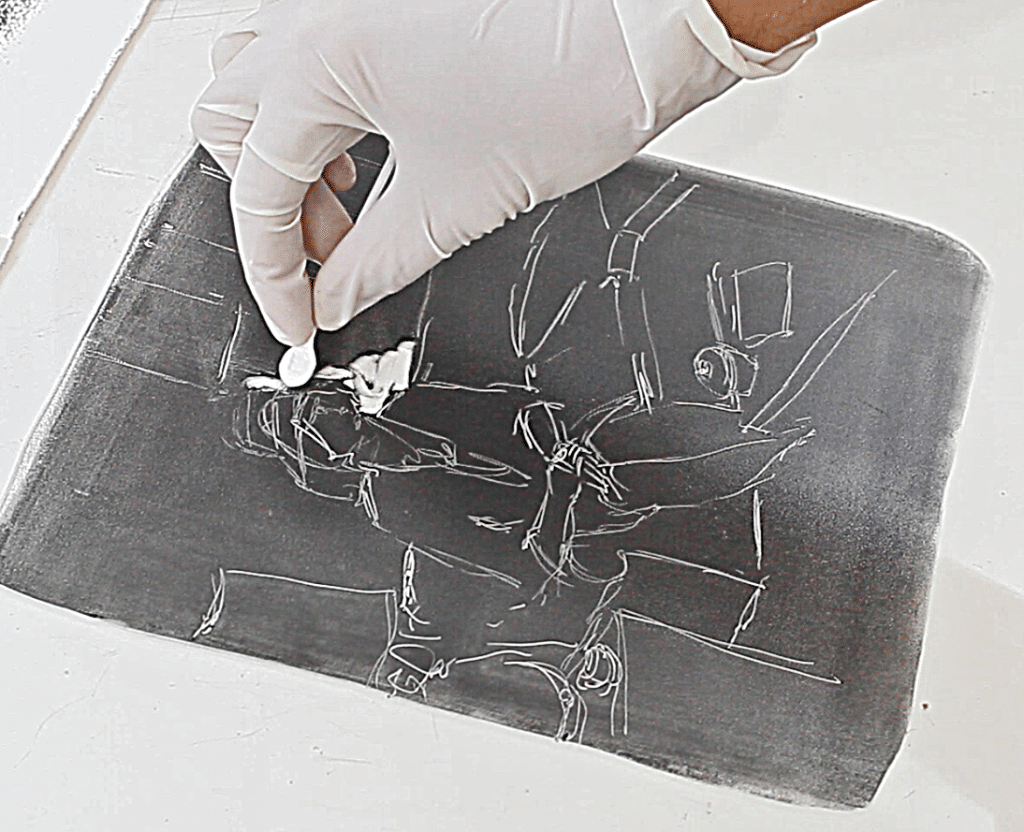
The space between the sides and the top should all be equal. In printmaking it is better to have more space on the bottom of the paper than have the image right in the middle. Then place your plate in the center of your outline for the paper.
MOMOTYPE PRINTMAKING REGISTRATION
To create a registration sheet trace a sheet if your torn paper onto a large piece of newsprint. After tearing paper use your initials to mark the top right corner on the back of the paper. To tear your paper use a tear bar or a large ruler and hold it down on your paper with a good amount of pressure then use your other hand to carefully tear. If you prefer to work larger you can tear your page in half or not tear it at all it's up to you. We were allowed one primary colour, my choice was blue, a printing plate, A4 Rhenalon, 0.5mm thick plastic and glass clear. Monotype Printmaking: Task 1 After a quick introduction and explanation Kate introduced our first printing task. The plate I am using is 8x10" which fits well into quarter sheets and gives me four prints. Monotype A single print taken from a design created in oil paint or printing ink on glass or metal. You want to avoid moving it once its touched the paint, or the image will smudge. Identify the watermark and turn your paper upside down for tearing. Exploration of materials and processes in Mono printing including: additive, subtractive, multicolor, viscosity and. Carefully place the piece of paper for the monotype onto the paint or ink. How you tell is by looking for the watermark which should be in the right hand corner if it is right side up.

Monotype printmaking is quick and satisfying.

The fact that you can pull out a plate, roll some ink on it, and start carving light into the image with a pencil eraser always delights me.
MOMOTYPE PRINTMAKING FULL
When the sheets were peeled apart, the transferred image became the final work of art.There is a front and a back to printmaking paper. I’ve been making painterly monotypes of one sort or another for 15 years, and they are still full of surprises. The process lets the participants create a rapid design or texture on a smooth plate and get a unique, ‘mono’ impression on paper. The pressure of the pencil caused the ink from the bottom sheet to transfer to the back of the top sheet. One of the most painterly printmaking techniques, monotypes mean the transfer of rolled on, scratched or brushed a layer of pigments or printing inks off a smooth plate onto a paper. Monotype Printmaking is the name given to a wide range of methods for painting an image on a surface and then transferring it to a sheet of paper, creating just one print. The harder and thinner your pencil (as well as your paper), the finer will be the resulting line.” A 144-page paperback book by Julia Ayres. A sheet of thin paper is laid over the ink film and a pencil or pen drawing is made. “First you roll out printer’s ink on a sheet of paper of any sort then lay a second sheet on top of it and draw whatever pleases you. A trace monotype is a one-off print where there is no matrix for an edition, just a very thin film of rolled out ink.

From MoMA’s blog by Lotte Johnson - in Gauguin’s words: The surface, or matrix, was historically a copper. Monotypes can also be created by inking an entire surface and then, using brushes or rags, removing ink to create areas of light from a solid area of opaque colour. Monotyping is a type of printmaking made by drawing or painting on a smooth, non-absorbent surface. I first learned of this technique when visiting the MoMA’s exhibition Metamorphoses: Paul Gauguin’s Oil Trace Drawings - not a fan of the content itself, I was fascinated by his invention of this technique to create rich textures and dramatic lighting. The image is transferred from the plate onto a sheet of paper by pressing the two together, usually using a printing-press. Monotypes are prized because of their unique. There are so many ways to do transfer monotype. monotype, in printmaking, a technique that generally yields only one good impression from each prepared plate. Please stay well! - and look out for our upcoming online classes. Meanwhile, we are sharing simple step-by-step print techniques from EFA Staff, Monitors and Instructors- to do at the safety of your home. HOW-TO-PRINT at HOME In solidarity to stop the spread of COVID-19, the printshop will be closed until further notice.


 0 kommentar(er)
0 kommentar(er)
